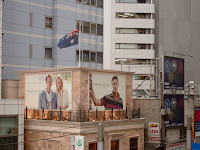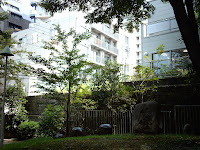 tions with those at the conference, as well as with Hisako-san I have been thinking about the two disasters that have struck Tokyo in this century, the Great Kanto earthquake of 1923, and the fire bombing of Tokyo by American Air Force in 1945.
tions with those at the conference, as well as with Hisako-san I have been thinking about the two disasters that have struck Tokyo in this century, the Great Kanto earthquake of 1923, and the fire bombing of Tokyo by American Air Force in 1945.So after some web searching, I went to visit Yokoamicho Park. It was busy with workmen setting up stalls etc, which on visiting the memorial halls, I realised it is for commemoration of the Kanto earthquake which struck Tokyo at 2 minutes to noon on September 1st 1923, the epicentre of which was 80 klms north-west of Tokyo.
The greatest loss o f life was from fires that raged through the city which was mainly made of wood. The fires burned for 42 hours and about 70% of the City was destroyed. The site of the Earthquake memorial hall, used to be an old army clothing depot that had closed, so many people headed there to escape the fire, as it was an open space. But fire, in the form of whirlwinds hit the area and killed all 58,000 people who were there.
f life was from fires that raged through the city which was mainly made of wood. The fires burned for 42 hours and about 70% of the City was destroyed. The site of the Earthquake memorial hall, used to be an old army clothing depot that had closed, so many people headed there to escape the fire, as it was an open space. But fire, in the form of whirlwinds hit the area and killed all 58,000 people who were there.
There is also a memorial to the 5000 children killed in the schools of the city. The hall hold the ashes of approximately 162,000 people who perished.
There has been a serious earthquake every 80 years, so Japan is 'overdue ' f
f or "the big one" and there is a lot of Municipal planning set up for that; but there is only so much you can do.
or "the big one" and there is a lot of Municipal planning set up for that; but there is only so much you can do.
There was a huge rebuilding after this with a lot of foreign aid and the museum has posters of the appeal as well as this graph of the quake.
It was only 22 years later that near the end of the war, the American Air force made 46 bombing runs over Tokyo in a few days and laid waste to the city. (March 10 1945) There was loss of 851,000 houses and loss of 105,000 civilians.
On looking for the place to visit I came across some controversy about the memorial It seems that while the earthquake is OK to acknowledge there has been great reluctance to acknowledge those lost in the bombing raids. It's almost a "don't talk about the war." Talking with Hisako she said that it was very hard after the war, even when she was about 10 and things were still very hard, she said the one thing she wanted to create was a clean toilet!
This green memorial (the fact that it is low and sort of underground, & has only a list of the names of all those known to have perished in the bombing raids) is also considered not enough.
On a lighter note (sort of) One thing that I hadn't put together was that Japan was the headquarters of the US coordinating the Korean war. I know Hawk Eye Pearce and co. in M.A.S.H. went to Tokyo for R & R, but didn't click that was because America was still here!
The greatest loss o
 f life was from fires that raged through the city which was mainly made of wood. The fires burned for 42 hours and about 70% of the City was destroyed. The site of the Earthquake memorial hall, used to be an old army clothing depot that had closed, so many people headed there to escape the fire, as it was an open space. But fire, in the form of whirlwinds hit the area and killed all 58,000 people who were there.
f life was from fires that raged through the city which was mainly made of wood. The fires burned for 42 hours and about 70% of the City was destroyed. The site of the Earthquake memorial hall, used to be an old army clothing depot that had closed, so many people headed there to escape the fire, as it was an open space. But fire, in the form of whirlwinds hit the area and killed all 58,000 people who were there.There is also a memorial to the 5000 children killed in the schools of the city. The hall hold the ashes of approximately 162,000 people who perished.
There has been a serious earthquake every 80 years, so Japan is 'overdue '
 f
f or "the big one" and there is a lot of Municipal planning set up for that; but there is only so much you can do.
or "the big one" and there is a lot of Municipal planning set up for that; but there is only so much you can do.There was a huge rebuilding after this with a lot of foreign aid and the museum has posters of the appeal as well as this graph of the quake.
It was only 22 years later that near the end of the war, the American Air force made 46 bombing runs over Tokyo in a few days and laid waste to the city. (March 10 1945) There was loss of 851,000 houses and loss of 105,000 civilians.
On looking for the place to visit I came across some controversy about the memorial It seems that while the earthquake is OK to acknowledge there has been great reluctance to acknowledge those lost in the bombing raids. It's almost a "don't talk about the war." Talking with Hisako she said that it was very hard after the war, even when she was about 10 and things were still very hard, she said the one thing she wanted to create was a clean toilet!

This green memorial (the fact that it is low and sort of underground, & has only a list of the names of all those known to have perished in the bombing raids) is also considered not enough.
On a lighter note (sort of) One thing that I hadn't put together was that Japan was the headquarters of the US coordinating the Korean war. I know Hawk Eye Pearce and co. in M.A.S.H. went to Tokyo for R & R, but didn't click that was because America was still here!















































